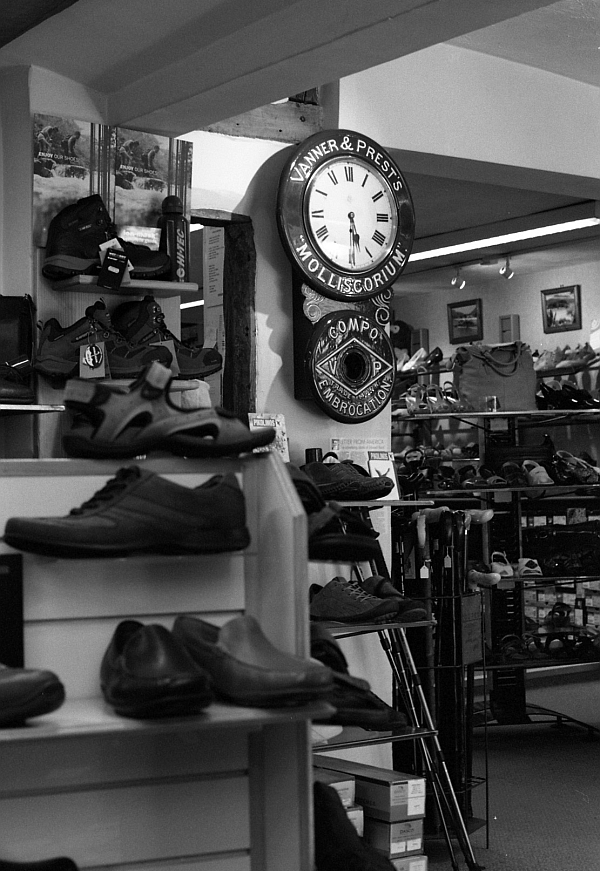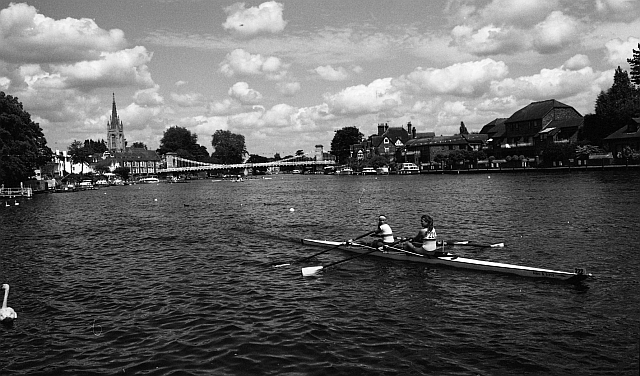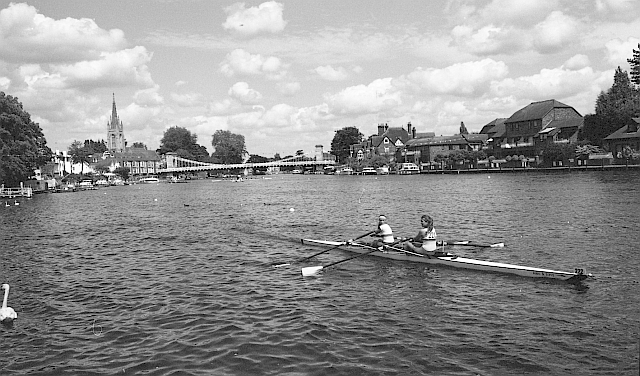| View previous topic :: View next topic |
| Author |
Message |
David

Joined: 13 Apr 2011
Posts: 1869
Location: Denver, Colorado
Expire: 2013-01-25
|
 Posted: Sat Sep 03, 2011 7:45 am Post subject: Film Review: Kodak BW400CN Posted: Sat Sep 03, 2011 7:45 am Post subject: Film Review: Kodak BW400CN |
 |
|
David wrote:
BW400CN is Kodak's C-41-process monochrome film. Ilford makes XP2, a similar product, with one noteworthy difference: The Kodak film is backed by yellow celluloid where the Ilford is backed by clear celluloid. Kodak's film translates B&W more accurately onto color print paper where Ilford's translates more accurately onto monochrome paper. I picked up a couple rolls of BW400CN and had a chance to shoot a few subjects.
The films are both built like and function like color film -- three emulsions layers each reacting to a different light wavelength. Instead of capturing color gradations, however, the crystals simply turn on and off like regular monochromatic film.
I performed two series tests with the film using various filters and filter combinations to see if it performed the same as standard black and white with filters. In short, it does. This should come as no surprise, though to me it kind of does. For some reason I expected the filters to have no effect. The BW400CN functioned exactly like 400 ISO standard monochromatic film.
As for quality, the image quality is decent. I somewhat prefer the image quality on TMax 400, but this film provides for more than a reasonable level of detail. Here are some test shots to illustrate some of the film's qualities.
Here are two sample photos, the first with, I believe, only a yellow filter. The second using a yellow and blue filter.


The vignetting is due to the filters, but not because they are present. The lens is a 52mm diameter. The yellow filter was a 52mm filter with a 55mm blue filter. On two similar photos with a 52mm red filter instead of each of the others, no vignetting occurred.

This photo was taken using either a red and blue or red and yellow filter pairing. I need to take better notes when I shoot. Anyway, this photo exhibits suitable detail with graininess beginning at about 50% (I scan the negatives in at 11X14 or 11X17, depending on content.

This image shows the film's ability to catch contrast while also retaining detail. This was taken with no filters, evidences by the glare.

This photo shows the film's ability to capture details. note the grass and tree bark. Had I been asked, I might not have guessed this photo to be from a 400 ISO film.
BW400CN is not all roses and happy-day la-las, however.


None of the images in this post received color balancing or conversion to monochrome. So you can see one of the film's downfalls: being based on a yellow base, scanning can cause coloration flaws in the finished scan. Note the different hue in each of the above shots. The top shot is slightly yellow while the bottom is slightly magenta. This may have been a scanner artifact, but the photos had wildly inconsistent casts across the roll.
In short, if you want to shoot monochrome but don't have a nearby lab that can process it cheaply or easily, BW400CN is a very good option. The film costs $6 or $7 here in California for a 24-exposure roll, which could be worthwhile if it's your only monochrome option.
_________________
http://www.youtube.com/user/hancockDavidM |
|
| Back to top |
|
 |
peterqd


Joined: 28 Feb 2007
Posts: 7448
Location: near High Wycombe, UK
Expire: 2014-01-04
|
 Posted: Sat Sep 03, 2011 9:59 am Post subject: Posted: Sat Sep 03, 2011 9:59 am Post subject: |
 |
|
peterqd wrote:
Very thoughtful and helpful review David, thankyou. About the colour cast, I feel this is more likely to be affected by the scanner software settings rather than the film. We've seen many pictures on ordinary mono film here on the forum which have a slight colour cast. To avoid it, the best thing I've found is to set the scanner software to capture in grayscale mode, or to convert each picture to grayscale afterwards, but that's more labour-intensive.
I also found that BW400CN displays a lot less grain than HP5+. Admittedly, I developed the HP5 myself so that could be a factor, but the C41 film was way better. Could it be that 3 layers of emulsion smooths out the graininess?
The only negative aspect I found (pardon the pun) was that all the images were markedly underexposed. I don't know if this was down to the film, the camera or even the cheap lab processing. Next time I'm going to rate it at about 320 or so and send it to a pro lab. Here's one of my smooooth captures (still in RGB mode by the way) 

_________________
Peter - Moderator |
|
| Back to top |
|
 |
Attila


Joined: 24 Feb 2007
Posts: 57865
Location: Hungary
Expire: 2025-11-18
|
 Posted: Sat Sep 03, 2011 1:31 pm Post subject: Posted: Sat Sep 03, 2011 1:31 pm Post subject: |
 |
|
Attila wrote:
Many thanks David!!
_________________
-------------------------------
Items on sale on Ebay
Sony NEX-7 Carl Zeiss Planar 85mm f1.4, Minolta MD 35mm f1.8, Konica 135mm f2.5, Minolta MD 50mm f1.2, Minolta MD 250mm f5.6, Carl Zeiss Sonnar 180mm f2.8
|
|
| Back to top |
|
 |
eeyore_nl


Joined: 09 Nov 2008
Posts: 837
Location: Netherlands
|
 Posted: Sat Sep 03, 2011 2:14 pm Post subject: Posted: Sat Sep 03, 2011 2:14 pm Post subject: |
 |
|
eeyore_nl wrote:
Thanks for the review!
As Peterqd already mentions, those films work better at 320ASA or slower. BW400CN can handle massive amounts of overexposure!
In my experience, Kodak BW400CN is very smooth with a huge tonal range, more so than Ilford XP2. On the other hand, BW400CN behaves very ugly when underexposed; more than XP2.
I think that I like XP2 a bit better, but BW400CN is not bad at all. For me, there's no difference really in ease of scanning, despite the different base layer color.
BW400CN

XP2

_________________
Fujifilm X-Pro2 / Fujifilm X-T1 / some Sonnar & Takumar lenses |
|
| Back to top |
|
 |
Lloydy


Joined: 02 Sep 2009
Posts: 7794
Location: Ironbridge. UK.
Expire: 2022-01-01
|
 Posted: Sat Sep 03, 2011 4:36 pm Post subject: Posted: Sat Sep 03, 2011 4:36 pm Post subject: |
 |
|
Lloydy wrote:
Very interesting comments, I've just loaded the first roll of B&W in over 25 years in my AE1p - a roll of XP2 400.
I like the tones of this Kodak BW400CN though, especially eeyore's boat picture. The difference between the terrific detail of the boat and the background makes a great image.
_________________
LENSES & CAMERAS FOR SALE.....
I have loads of stuff that I have to get rid of, if you see me commenting about something I have got and you want one, ask me.
My Flickr https://www.flickr.com/photos/mudplugga/
My ipernity -
http://www.ipernity.com/home/294337 |
|
| Back to top |
|
 |
eeyore_nl


Joined: 09 Nov 2008
Posts: 837
Location: Netherlands
|
 Posted: Sat Sep 03, 2011 4:40 pm Post subject: Posted: Sat Sep 03, 2011 4:40 pm Post subject: |
 |
|
eeyore_nl wrote:
| Lloydy wrote: |
Very interesting comments, I've just loaded the first roll of B&W in over 25 years in my AE1p - a roll of XP2 400.
I like the tones of this Kodak BW400CN though, especially eeyore's boat picture. The difference between the terrific detail of the boat and the background makes a great image. |
BW400CN is not very contrastry when you scan it, as you can see. I have another version of this same picture where I manually increased contrast.
However, it is always a trade-off between contrast and fine details.
Ilford XP2 is more contrastry, but also more grainy. OTOH, it behaves a bit better when underexposed.
_________________
Fujifilm X-Pro2 / Fujifilm X-T1 / some Sonnar & Takumar lenses |
|
| Back to top |
|
 |
peterqd


Joined: 28 Feb 2007
Posts: 7448
Location: near High Wycombe, UK
Expire: 2014-01-04
|
 Posted: Sat Sep 03, 2011 6:02 pm Post subject: Posted: Sat Sep 03, 2011 6:02 pm Post subject: |
 |
|
peterqd wrote:
David, here's an original scan from the same roll to show you the underexposure of BW400CN at box speed. Pentax ESII and SMC Tak 50/1.4

But no problem to add a little gamma

_________________
Peter - Moderator |
|
| Back to top |
|
 |
eeyore_nl


Joined: 09 Nov 2008
Posts: 837
Location: Netherlands
|
 Posted: Sat Sep 03, 2011 6:31 pm Post subject: Posted: Sat Sep 03, 2011 6:31 pm Post subject: |
 |
|
eeyore_nl wrote:
Peter, I usually shoot XP2 or BW400CN at 320ASA.
I once saw a BW400CN test somewhere which showed that even at 10 stops overexposure there were still details in the highlights! So it's much better to overexpose a bit, even more than with regular C-41 negative film.
_________________
Fujifilm X-Pro2 / Fujifilm X-T1 / some Sonnar & Takumar lenses |
|
| Back to top |
|
 |
peterqd


Joined: 28 Feb 2007
Posts: 7448
Location: near High Wycombe, UK
Expire: 2014-01-04
|
 Posted: Sat Sep 03, 2011 6:52 pm Post subject: Posted: Sat Sep 03, 2011 6:52 pm Post subject: |
 |
|
peterqd wrote:
| eeyore_nl wrote: |
Peter, I usually shoot XP2 or BW400CN at 320ASA.
I once saw a BW400CN test somewhere which showed that even at 10 stops overexposure there were still details in the highlights! So it's much better to overexpose a bit, even more than with regular C-41 negative film. |
Thanks eeyore, I have another roll ready and I'll take your advice. 
_________________
Peter - Moderator |
|
| Back to top |
|
 |
eeyore_nl


Joined: 09 Nov 2008
Posts: 837
Location: Netherlands
|
 Posted: Sat Sep 03, 2011 7:32 pm Post subject: Posted: Sat Sep 03, 2011 7:32 pm Post subject: |
 |
|
eeyore_nl wrote:
| peterqd wrote: |
Thanks eeyore, I have another roll ready and I'll take your advice.  |
A little test I once did with Ilford XP2: (all processed in the same way; contrast stretched and some USM)
ISO800

ISO400

ISO200

_________________
Fujifilm X-Pro2 / Fujifilm X-T1 / some Sonnar & Takumar lenses |
|
| Back to top |
|
 |
IANUS


Joined: 14 Oct 2008
Posts: 276
Location: Germany
|
 Posted: Wed Sep 14, 2011 9:51 am Post subject: Posted: Wed Sep 14, 2011 9:51 am Post subject: |
 |
|
IANUS wrote:
| Quote: |
A little test I once did with Ilford XP2: (all processed in the same way; contrast stretched and some USM)
|
Nice test.
The BW400CN is/was one of my favourites since I am not processing by my own. Unfortunately it isn't available in 120 anymore. I got me XP2 in 120 for my Rolleicord but haven't tested yet. How do you rate the XP2 film (ISO 320?). I used the BW400CN normally at ISO250 or 320 depending on camera. |
|
| Back to top |
|
 |
Orio

Joined: 24 Feb 2007
Posts: 29545
Location: West Emilia
Expire: 2012-12-04
|
 Posted: Wed Sep 14, 2011 10:58 am Post subject: Posted: Wed Sep 14, 2011 10:58 am Post subject: |
 |
|
Orio wrote:
| peterqd wrote: |
| To avoid it, the best thing I've found is to set the scanner software to capture in grayscale mode, or to convert each picture to grayscale afterwards, but that's more labour-intensive. |
Scanning in grayscale mode happens at 8bit resolution and I do not recommend it.
Better to scan in RGB at 24bit or even better 48bit resolution if possible, process the image if necessary,
and only as final step convert the image to grayscale using the channel mixer or other similar tool.
_________________
Orio, Administrator
T*
NE CEDE MALIS AUDENTIOR ITO
Ferrania film is reborn! http://www.filmferrania.it/
Support the Ornano film chemicals company and help them survive!
http://forum.mflenses.com/ornano-chemical-products-t55525.html |
|
| Back to top |
|
 |
|
|
|
You cannot post new topics in this forum
You cannot reply to topics in this forum
You cannot edit your posts in this forum
You cannot delete your posts in this forum
You cannot vote in polls in this forum
|
